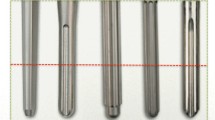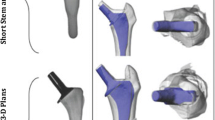Abstract
Background
Experimental studies have suggested that initial micromotion of cementless components may lead to failure of osteointegration. Roentgen stereophotogrammetric analyses have shown durable implant fixation can be achieved long-term even when initial instability exists, as evidenced by subsidence. However improved implant stability as a result of subsidence, before osteointegration, has not been shown biomechanically.
Questions/purposes
We asked whether insertionally loose cementless tapered femoral stems show (1) less rotational stability (more toggle); (2) more subsidence; and (3) reduced ability to resist torsion (lower initial construct stiffness), lower torque at failure, and greater rotation to failure in comparison to well-fixed cementless tapered femoral stems.
Methods
Ten matched pairs of cadaveric femurs were implanted with well-fixed and loose cementless tapered stems. The loose stem construct was obtained by appropriately broaching the femur but afterwards inserting a stem one size smaller than that broached. Femoral stem rotational stability of implanted femurs was tested by measuring the angular rotation (ie, toggle) required to produce a torque of 2 N-m at 0 N, 250 N, and 500 N vertical load in 25° adduction simulating single-legged stance. Subsidence was measured as vertical movement during the toggle tests. Then at 500 N initial vertical load, femoral stems were externally rotated to failure. The construct stiffness between 5 and 40 N-m was determined to assess ability to resist torsion. The torque and rotation to failure were recorded to compare failure characteristics. Groups were compared using mixed model ANOVA followed by Tukey–Kramer post hoc pairwise comparison for toggle and subsidence tests and by Student’s paired t-tests for stiffness, torque at failure, and rotation to failure tests.
Results
Loose tapered cementless stems were less stable (ie, more toggle) than well-fixed at 0 N of load (p < 0.0001), but no difference was detectable in toggle between loose and well-fixed stems at 250 N (p = 0.7019) and 500 N (p = 0.9970). Loose tapered cementless stems showed significant subsidence at 250 N (p < 0.0001) and 500 N (p < 0.0001), which was not found in the well-fixed stems at 250 N (p = 0.8813) and 500 N (p = 0.1621). Torsional stiffness was lower for loose stems as compared with well-fixed stems (p = 0.0033). No difference in torque at failure (p = 0.7568) or rotation to failure (p = 0.2629) was detected between loose and well-fixed stems.
Conclusions
In this study, we observed that insertionally loose cementless stems have the ability to subside and become rotationally stable with loading. They did not exhibit a lower torque or rotation to failure in comparison to well-fixed stems when under simulated single-legged stance.
Clinical Relevance
Secondary rotational stabilization may prevent insertionally loose tapered stems from producing a stress pattern that predisposes to early postoperative periprosthetic fracture around loose cemented stems.





Similar content being viewed by others
References
Abdulkarim A, Ellanti P, Motterlini N, Fahey T, O’Byrne JM. Cemented versus uncemented fixation in total hip replacement: a systematic review and meta-analysis of randomized controlled trials. Orthop Rev (Pavia). 2013;5:e8.
Berend ME, Smith A, Meding JB, Ritter MA, Lynch T, Davis K. Long-term outcome and risk factors of proximal femoral fracture in uncemented and cemented total hip arthroplasty in 2551 hips. J Arthroplasty. 2006;21(6 suppl 2):53–59.
Berry DJ, Bozic KJ. Current practice patterns in primary hip and knee arthroplasty among members of the American Association of Hip and Knee Surgeons. J Arthroplasty. 2010;25(6 suppl):2–4.
Cooper HJ, Rodriguez JA. Early post-operative periprosthetic femur fracture in the presence of a non-cemented tapered wedge femoral stem. HSS J. 2010;6:150–154.
Corten K, Bourne RB, Charron KD, Au K, Rorabeck CH. Comparison of total hip arthroplasty performed with and without cement: a randomized trial. A concise follow-up, at twenty years, of previous reports. J Bone Joint Surg Am. 2011;93:1335–1338.
Dennis MG, Simon JA, Kummer FJ, Koval KJ, Di Cesare PE. Fixation of periprosthetic femoral shaft fractures: a biomechanical comparison of two techniques. J Orthop Trauma. 2001;15:177–180.
Fulkerson E, Koval K, Preston CF, Iesaka K, Kummer FJ, Egol KA. Fixation of periprosthetic femoral shaft fractures associated with cemented femoral stems: a biomechanical comparison of locked plating and conventional cable plates. J Orthop Trauma. 2006;20:89–93.
Grammatopoulos G, Pandit H, Kambouroglou G, Deakin M, Gundle R, McLardy-Smith P, Taylor A, Murray D. A unique peri-prosthetic fracture pattern in well fixed femoral stems with polished, tapered, collarless design of total hip replacement. Injury. 2011;42:1271–1276.
Harris B, Owen JR, Wayne JS, Jiranek WA. Does femoral component loosening predispose to femoral fracture? An in vitro comparison of cemented hips. Clin Orthop Relat Res. 2010;468:497–503.
Harris WH, Mulroy RD Jr, Maloney WJ, Burke DW, Chandler HP, Zalenski EB. Intraoperative measurement of rotational stability of femoral components of total hip arthroplasty. Clin Orthop Relat Res. 1991;266:119–126.
Jasty M, Bragdon C, Burke D, O’Connor D, Lowenstein J, Harris WH. In vivo skeletal responses to porous-surfaced implants subjected to small induced motions. J Bone Joint Surg Am. 1997;79:707–714.
Kärrholm J, Malchau H, Snorrason F, Herberts P. Micromotion of femoral stems in total hip arthroplasty: a randomized study of cemented, hydroxyapatite-coated, and porous-coated stems with roentgen stereophotogrammetric analysis. J Bone Joint Surg Am. 1994;76:1692–1705.
Krismer M, Biedermann R, Stöckl B, Fischer M, Bauer R, Haid C. The prediction of failure of the stem in THR by measurement of early migration using EBRA-FCA: Einzel-Bild-Roentgen-Analyse-femoral component analysis. J Bone Joint Surg Br. 1999;81:273–280.
Lindahl H, Malchau H, Herberts P, Garellick G. Periprosthetic femoral fractures classification and demographics of 1049 periprosthetic femoral fractures from the Swedish National Hip Arthroplasty Register. J Arthroplasty. 2005;20:857–865.
Morshed S, Bozic KJ, Ries MD, Malchau H, Colford JM Jr. Comparison of cemented and uncemented fixation in total hip replacement: a meta-analysis. Acta Orthop. 2007;78:315–326.
Noble AR, Branham DB, Willis MC, Owen JR, Cramer BW, Wayne JS, Jiranek WA. Mechanical effects of the extended trochanteric osteotomy. J Bone Joint Surg Am. 2005;87:521–529.
Pilliar RM, Lee JM, Maniatopoulos C. Observations on the effect of movement on bone ingrowth into porous-surfaced implants. Clin Orthop Relat Res. 1986;208:108–113.
Radl R, Aigner C, Hungerford M, Pascher A, Windhager R. Proximal femoral bone loss and increased rate of fracture with a proximally hydroxyapatite-coated femoral component. J Bone Joint Surg Br. 2000;82:1151–1155.
Streit MR, Merle C, Clarius M, Aldinger PR. Late peri-prosthetic femoral fracture as a major mode of failure in uncemented primary hip replacement. J Bone Joint Surg Br. 2011;93:178–183.
Wu CC, Au MK, Wu SS, Lin LC. Risk factors for postoperative femoral fracture in cementless hip arthroplasty. J Formos Med Assoc. 1999;98:190–194.
Zdero R, Walker R, Waddell JP, Schemitsch EH. Biomechanical evaluation of periprosthetic femoral fracture fixation. J Bone Joint Surg Am. 2008;90:1068–1077.
Author information
Authors and Affiliations
Corresponding author
Additional information
One of the authors certifies that he (WAJ), or a member of his immediate family, has or may receive payments or benefits, during the study period, in the amount of USD 100,001–USD 1,000,000 from DePuy Orthopaedics, Inc. (Warsaw, IN, USA). The institution of the authors has received, during the study period, funding in the amount of USD 10,000–USD 100,000 from MEDARVA Healthcare (Richmond, VA, USA). Implants for this study were donated by Stryker Inc (Mahwah, NJ, USA).
All ICMJE Conflict of Interest Forms for authors and Clinical Orthopaedics and Related Research editors and board members are on file with the publication and can be viewed on request.
Clinical Orthopaedics and Related Research neither advocates nor endorses the use of any treatment, drug, or device. Readers are encouraged to always seek additional information, including FDA-approval status, of any drug or device prior to clinical use.
About this article
Cite this article
Kannan, A., Owen, J.R., Wayne, J.S. et al. Loosely Implanted Cementless Stems May Become Rotationally Stable After Loading. Clin Orthop Relat Res 472, 2231–2236 (2014). https://doi.org/10.1007/s11999-014-3577-y
Received:
Accepted:
Published:
Issue Date:
DOI: https://doi.org/10.1007/s11999-014-3577-y




